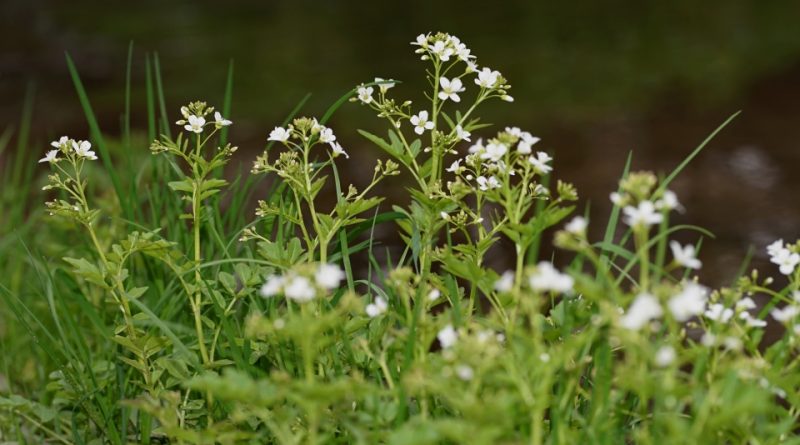Cardamine amara
Cardamine amara
The large bitter-cress (Cardamine amara L.) is a herbaceous species belonging to the Brassicaceae family.
Systematic –
From a systematic point of view it belongs to:
Eukaryota domain,
Kingdom Plantae,
Subkingdom Tracheobionta,
Spermatophyta Superdivision,
Division Magnoliophyta,
Class Magnoliopsida,
Subclass Dilleniidae,
Capparales Order,
Brassicaceae family,
Tribe Cardamineae,
Genus Cardamine,
Species C. amara.
The terms are synonymous:
– Cardamine amara f. umbrosa (Lej.) Bolzon;
– Cardamine amara subsp. multijuga Uechtr.;
– Cardamine amara var. umbrosa (Lej.) DC.;
– Cardamine bielzii Schur;
– Cardamine crassifolia Opiz, 1826;
– Cardamine hirta Wimm. & Grab., 1827;
– Cardamine opicii J.Presl & C.Presl;
– Cardamine umbrosa Lej.;
– Cardamine wiedemanniana Boiss..
The following subspecies are recognized within this species:
– Cardamine amara subsp. amara;
– Cardamine amara subsp. austriaca Marhold;
– Cardamine amara subsp. balcanica Marhold, Ančev & Kit Tan;
– Cardamine amara subsp. olotensis O.Bolòs;
– Cardamine amara subsp. opicii Čelak.;
– Cardamine amara subsp. opizii (C.Presl & J.Presl) Čelak.;
– Cardamine amara subsp. pyrenaea Sennen.
Etymology –
The term Cardamine comes from the Greek καρδαμίνη kardamíne (in Dioscorides) formed, according to Linnaeus, from κάρ car (heart) and δαμάω domo (tame, conquer) for the supposed positive effects in heart diseases.
The specific epithet amara is attributed due to the bitter, acrid taste.
Geographic Distribution and Habitat –
Cardamine amara is a plant with Eurasian distribution, widespread in most of Europe, with the upper limit in Finland and from Great Britain to the Balkans and western Asia.
It is present, with three subspecies, in all regions of northern Italy and in Tuscany. The regional distribution extends over almost the entire territory, but with several gaps in the Trieste Karst, near the coasts, and in the magredile areas of the upper Friulian plain.
Its habitat is that of the banks of alpine and mountain streams, swamps, from approximately 600 m to 2500 m (it rarely descends to the sea).
Description –
Cardamine amara is a perennial plant with erect, mostly unbranched stems up to 70 cm tall.
The leaves are composed of three to 13 leaflets and the basal leaves form a rosette budding from the stolon, petiolate, impartipinnate, of a pinnate shape with 3 – 5 segments with a larger apical leaflet and of an obovate-reniform shape, margin ± ciliated (3) – 8 – 10 cm.
The inflorescences are loose apical racemes that elongate during fruiting. The flowers are regular (actinomorphic), pedunculated, with a calyx made up of 4 yellowish sepals, the two lateral sepals being pouched.
The flower is made up of a corolla, about 1.5 cm long, with 4 white petals sometimes flecked with pink or violet arranged in a cross. There are 6 stamens, 4 of which are long and 2 short (tetradynamides) and the anthers are violet in colour. The style is single, simple with stigma without lateral swellings (capitate) on a bicarpellary syncarpic superovary.
The plant flowers from May to August.
The fruit is an erect, flat, non-articulated silique, 2-3 cm long, with two flat valves with an opening lengthwise from which numerous seeds are released; these are numerous, arranged in a row per niche, measuring 0.9-1.4 x 07-1 mm, greenish-brown.
Cultivation –
Cardamine amara is a perennial, polymorphic plant that is harvested in the wild for local use as a food and medicine.
It is an easy-to-grow plant that prefers moist, humus-rich soil in the shade or partial shade.
The plants are resistant to at least -20 °C.
In suitable conditions it can become an invasive plant that spreads by spontaneous sowing.
Propagation occurs by seed. Sowing should be done in the open field in a shaded position in mid-spring.
Customs and Traditions –
Cardamine amara is a plant that mostly grows spontaneously but is collected by local populations for its leaves which are edible and can be used to flavor salads and soups, thanks to their spicy flavor similar to that of watercress.
The leaves with a spicy flavor similar to that of watercress can be used to flavor salads and soups.
In the past it was used in phytotherapy; an infusion of this plant was used as a purifier, diuretic and anti-anemic.
C. amara is recognized as having antianemic, antiscorbutic, diuretic, remineralizing, antidiabetic, liver cleansing and respiratory decongestant properties.
Preparation Method –
Cardamine amara is a plant whose basal leaves, especially in spring, were once mainly used to flavor salads and soups, thanks to their spicy flavor similar to that of watercress.
The leaves are eaten raw.
In the medicinal field it is recognized as having antiscorbutic, diuretic and stimulant properties.
No other uses are known.
Guido Bissanti
Sources
– Acta Plantarum – Flora of the Italian Regions.
– Wikipedia, the free encyclopedia.
– GBIF, the Global Biodiversity Information Facility.
– Useful Tropical Plants Database.
– Conti F., Abbate G., Alessandrini A., Blasi C. (ed.), 2005. An annotated checklist of the Italian vascular flora, Palombi Editore.
– Pignatti S., 1982. Flora d’Italia, Edagricole, Bologna.
– Treben M., 2000. Health from the Lord’s Pharmacy, Advice and experiences with medicinal herbs, Ennsthaler Editore.
Photo source:
– https://inaturalist-open-data.s3.amazonaws.com/photos/267157565/original.jpeg
Attention: Pharmaceutical applications and food uses are indicated for informational purposes only, they do not represent in any way a medical prescription; we therefore decline any responsibility for their use for healing, aesthetic or food purposes.


